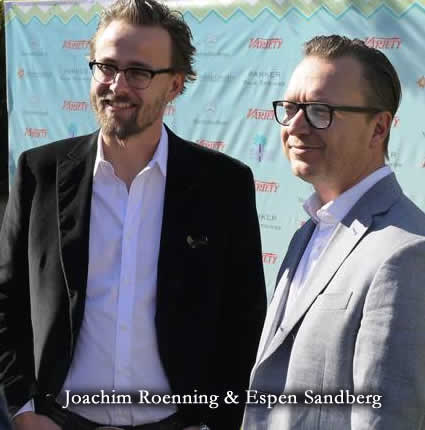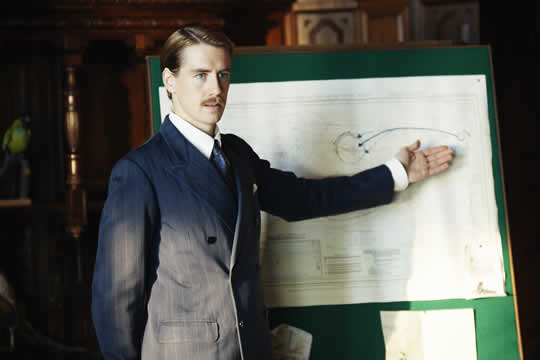 KON-TIKI, nominated for the Best Foreign Language Film Oscar happens half a century ago, when a young Norwegian adventurer Thor Heyerdahl became one of history’s most famous men with the Kon-Tiki voyage, an astonishing journey of 4,300 nautical miles across the Pacific Ocean on a balsawood raft. But this is not the whole story.
KON-TIKI, nominated for the Best Foreign Language Film Oscar happens half a century ago, when a young Norwegian adventurer Thor Heyerdahl became one of history’s most famous men with the Kon-Tiki voyage, an astonishing journey of 4,300 nautical miles across the Pacific Ocean on a balsawood raft. But this is not the whole story.
A handsome and charismatic figure, Thor developed a theory that Polynesia had been settled by peoples travelling east from South America, not west from Asia as previously thought. No-one in the scientific community took him seriously, to say nothing of having it published. After an American professor jokingly told Thor to try sailing from Peru to Polynesia on a balsawood raft, Thor realized that this is what he must do. He decided to prove his theory by sailing the legendary voyage himself.
Christening his raft ’Kon-Tiki’ after a sun-god, Thor set sail from Peru along with five daring crew, none of whom knew each other. Only one knew how to sail. Though he was afraid of water and couldn’t swim, Thor was willing to sacrifice everything and everyone to prove himself right…
Childhood friends Joachim Roenning (40) and Espen Sandberg (41), directors of KON-TIKI, grew up in southern Norway in the ‘80s. Amongst the first video generation, they spent their spare time making short films with a massive 30-pound home video camera belonging to Joachim’s father.
We had the opportunity of interviewing Espen Sandberg about KON-TIKI.
Bijan Tehrani: How did you guys come up with the idea of making KON-TIKI?
Espen Sandberg: We grew up in the native town of Thor actually so we’ve known about him and the Kon-Tiki since we were kids. He was a big inspiration to us because he was also the first Norwegian to win an Academy Award. It’s a great story, we remember going to the Kon-Tiki museum in Oslo where the raft is and it’s a kid’s dream to go on a raft! When you go down in the basement, you get under the raft and there’s a whale shark and that really sparked our imagination. We actually tried to make it and then we learned that Jeremy Thomas, a British producer, had the rights and he was going to make it into a Hollywood movie so we forgot about that for a while and we worked on Max Manus, our previous movie, and then Jeremy Thomas saw that film and loved it. He asked us basically if we would like to make Kon-Tiki; of course we said yes!
BT: This story is not only inspiring but at this time, we need this kind of encouragement, that kind of old-time fantasies that we had when we were kids. I think this generation is lacking that with whatever they are watching on TV. This is such an interesting comeback to that kind of story.
ES: Yes, I think you’re right. I think people love something like that. I have kids and they have a bicycle helmet, and a helmet for skiing, and a helmet for this and that, we get a little scared and we don’t dare maybe as much as we used to… And the great story about Thor is that he couldn’t swim! He was actually terrified of water, he almost drowned twice growing up, yet in spite of that he went on the raft and crossed the biggest ocean on earth. It’s a great lesson to be learned: if you can overcome your fears, you can do anything basically!
BT: Exactly!
ES: We believe that’s also why he sold 50 million copies of the book about Kon-Tiki, not because people loved migration theories. It’s a great adventure and it helps you with how your life can be an adventure too if you just dare to go.
BT: I’m originally an Iranian filmmaker and I also don’t know how to swim, and when I was young I wanted to go on a raft from Africa to Iran to show that there were people who came from Africa to the South of Iran – that’s a true story. I never made it happen; I never had the courage of Thor.
ES: (laughs)
BT: Actors’ performances in the film is amazing! How did you go about casting?
ES: We knew Pål Sverre Hagen who plays the role of Thor already: he plays in our previous film, Max Manus. And the great thing about Pål is – of course he’s an amazing  actor and he looks the part, but he was actually about to study biology when he was accepted at theater school, so he has the same interests that Thor had and he can relate to him on so many levels. It was really a gift for us on the movie to have Pål with us. We cast basically around him, trying to find the right balance. Some of them are very well known in Norway, and some of them have no features at all before. When we did the casting, we also did all the rehearsals with Pål so he was always the one that all the other actors had to play with, so in that way, we sort of gave him the role of captain from the get-go.
actor and he looks the part, but he was actually about to study biology when he was accepted at theater school, so he has the same interests that Thor had and he can relate to him on so many levels. It was really a gift for us on the movie to have Pål with us. We cast basically around him, trying to find the right balance. Some of them are very well known in Norway, and some of them have no features at all before. When we did the casting, we also did all the rehearsals with Pål so he was always the one that all the other actors had to play with, so in that way, we sort of gave him the role of captain from the get-go.
BT: I think it’s very important because everything comes natural in the film. Did you leave any room for improvisation when you were shooting this film?
ES: Not really, because we shot it in two different languages – we shot it in Norwegian and in English – and we did it in 69 days, so we didn’t really have time for that. But having said that, we did work very closely with the actors each and every day and what we worked on a lot with them was to reduce dialogue, because we spoke to people who had gone on raft trips like that and they said you talk a lot the first few days, but when you’ve been out there for a while you’ve basically talked about everything. You talk less and less. So for us it was about distilling the dialogue a bit more in the acting and the actors were very much involved in that process.
BT: The visual style of the film is very interesting – it lends itself to the world of adventure but at the same time it’s a world of fantasy and reality mixed together. How did you come up with the visual style of the film?
ES: We watched a lot of old films, adventure films, films like Lawrence of Arabia, movies with a lot of horizon in them. You can see that in the movie I’m sure. At the same time, because there are so many visual effects, we knew that it could feel restraining and sometimes you have to plan the shot so carefully that you can feel it later on in the movie.. so it was very important for us to be free. We had two cameras that we shot with at the same time, and we did a lot on the raft hand-held to give the actors as much freedom as possible. Even though we have a lot of effects, we tried to plan them so well that we could still be free within certain limits. Also, we tried to always put the camera only where you could have a camera, meaning that we are on the raft almost all the time as well with the camera and sometimes we are outside – on most CGR shots. When it’s a CGR shot, like the wave in the end, you can basically put the camera wherever you want but we wanted to feel like that was real too.
BT: Going back to the subject of the film, I think we’re in a world in which we deal with a lot of dark issues every day and our horizons are limited. This film helps in that we feel better and we feel that maybe there are more things to discover still for us. Did you have that intention when making the film?
ES: Well, we wanted it to be inspirational. Thor was very much a role model and he said, “I’ve heard about borders, I’ve never seen one but I hear that they exist in the minds of some people.” He was a very international man and a very open-minded man and we talked a lot about that. I hope we also have some of his spirituality and mindset in the movie – that was our goal at least.
minds of some people.” He was a very international man and a very open-minded man and we talked a lot about that. I hope we also have some of his spirituality and mindset in the movie – that was our goal at least.
BT: One thing about this film is while it is not a Hollywood movie, it reopens the opportunity to have all kinds of merchandise, like comic books… Have you thought of those opportunities?
ES: We didn’t think about that actually. There is a lot of merchandise already because there is a Kon-Tiki museum in Oslo and they sell clothes, miniatures of the raft, and of course Thor’s books and all the books about the Kon-Tiki expedition.. so there is a lot of merchandise but that belongs to the museum. We don’t add any on top of that.
BT: How do you see your chances of winning the Academy Award for the Best Foreign Language movie?
ES: We’ve done the math and it’s 20%. Having said that, for a movie from Norway, we feel in many ways that we won already because the kind of attention that we get for this movie is fantastic. It has only opened in Norway so far so now to make the titles all over the world before it opens is the best beginning we could ever wish for.
BT: Any future projects that you are working on?
ES: Yes, we are working on several projects, including some in the US. Right now we are in development with a project at Warner, with Legendary Pictures, and then we’ll see how it goes. We are getting much attention now with the Oscars and we’ll see what it leads to. We are meeting some great people and hoping to make the most of it.
BT: I wish you luck and success with your great film.
ES: Thank you so much.
